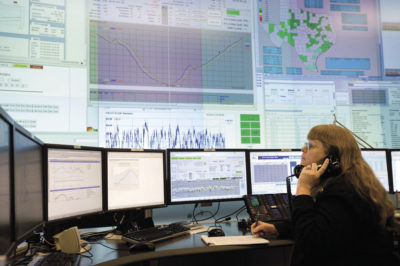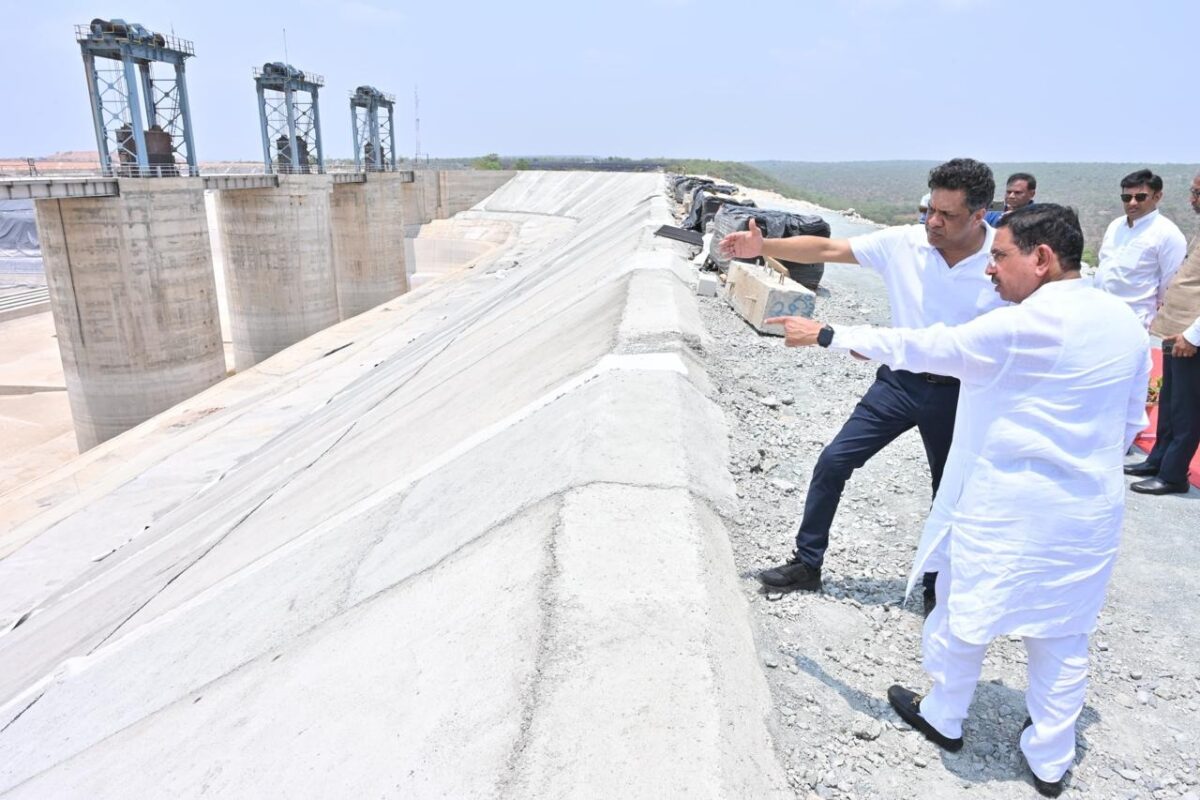From pv magazine Global, February 2019
While we often speak of electricity supply in terms of raw power inputs and demand – whether from gigawatt-scale nuclear plants, the terawatt hours of annual demand in each U.S. state or even 15 W light bulbs – there is another dimension that is less discussed but no less critical: frequency.
The three main U.S. grids run on a frequency of 60 cycles per second (60 hertz), and European grids on 50 Hz. Any significant deviation from this would wreck electrical equipment, including the appliances of end users, and as a result relays are set to trip if the grid exceeds a relatively narrow band of acceptable frequencies.
These frequencies can rise or fall if there is an imbalance between the supply of power and end user demand. When this happens, the enormous spinning bulk of turbines at hydro, gas, coal, oil or nuclear plants can help address the problem until more resources are brought online.
This entire system is under threat, as large generators are going offline and being replaced by wind, solar and batteries, which have no large spinning masses. While wind can supply “synthetic inertia” to compensate this is not the same. Eventually a whole new system will need to be created if we are to transition entire grids to renewable energy resources.
Frequency control
While keeping the frequency of the grid within a narrow range is one of the central tasks of maintaining power supply, the bulk power system typically doesn’t wander out of standard frequency on its own. Deviation usually occurs when there is a mismatch between supply and demand – as occurs if a large generator goes offline, for example.
A common misunderstanding about frequency control is the idea that large spinning masses keep the power grid at a stable frequency during times of imbalance between supply and demand. “Inertia only sets the initial rate at which the frequency falls – it buys you time,” notes Mark Ahlstrom, an engineer who works with the Energy Systems Integration Group (ESIG). He says, ultimately, frequencies will not stabilize until the supply and demand balance is corrected.
In the 20th century, this was the system for frequency stabilization. The grid was comprised solely of large generators with heavy steam and hydroelectric turbines and, in early years, motors connected to the grid provided additional inertia. But the 21st century grid is different. Notably, these large spinning masses are being replaced with wind and solar power plants that do not have the same characteristics: For solar there is no spinning mass at all.
This does not mean that inverters are not capable of frequency control. In fact, they can react much faster than the primary frequency response which is currently deployed. “They are about as fast as you can get,” explains Ahlstrom. In fact, if needed, inverters can respond so quickly to restore frequency that the initial supply-demand imbalance could go undetected, causing other problems.
This danger – that inverters could respond too quickly – underscores the difference between perception and actual needs regarding frequency control. In the current system, frequency deviations serve as a necessary warning that supply and demand are imbalanced.
FERC freak out
In the United States, regulators have observed the retirement of conventional generation and its replacement with wind and solar and have been concerned about insufficient inertia. In 2009, the Federal Energy Regulatory Commission (FERC) began a process that culminated last February in Order 842, which required large and small power plants to “install, maintain and operate equipment capable of providing primary frequency response (PFR) as a condition of interconnection” in order to “address the potential reliability impact of the evolving generation resource mix”.
In comments made in 2016, environmental group the Sierra Club and the Sustainable FERC Project argued there is adequate PFR in all interconnections, and that over the longer term FERC should “explore measures other than mandates” to ensure compliance with reliability standards – including encouraging “procurement of fast-acting demand response from storage and other demand-side resources”.
Experts who pv magazine spoke to ave also suggested this may be an overreaction on FERC’s part. “In the Eastern and Western [USA] Interconnections, there probably isn’t a problem for the next couple of decades,” notes ESIG’s Ahlstrom.
However, in the Electric Reliability Council of Texas (ERCOT) grid, things may be different. Wind represented 19% of the electricity generated in ERCOT last year, and wind output has already peaked at more than half of instantaneous demand. As a result, some of the biggest concerns about the loss of inertia and frequency control have come from ERCOT.
But even in the Eastern and Western interconnections, if more ambitious transitions to renewable energy are realized – such as U.S. Representative Alexandria Ocasio-Cortez’s call for 100% renewable energy by 2030 – these problems will have to be grappled with.
Grid-following, or grid-forming?
Wind plants have the ability to supply what has been called “synthetic inertia” by essentially overdriving to give a little more oomph. However, multiple experts express disdain for this term, noting that what wind turbines supply is not inertia, but extra power. This doesn’t correct frequency as much as it alleviates a portion of the imbalance which caused the frequency deviation in the first place.
Inverters can be programmed to help to control frequency as well, and the way PV plants are operated can be a factor in the ability to provide frequency response. “If you were going to provide fast frequency response from PV plants, you would have to be running in a partially curtailed state,” explains Ahlstrom.
Additionally, storage devices can provide frequency support and balance supply and demand, and these can be available at times when solar and wind are not.
But a bigger question is whether it is best to use inverters this way. With inverters, we aren’t stuck with the characteristics of large spinning masses, and have more options to provide system stability.
Broadly speaking, there are two main ways to use inverters for frequency control: grid-following or grid-forming. Grid-following inverters measure the grid voltage and frequency and inject the correct real and reactive power. Grid-forming inverters create a local voltage and frequency, and then try to move that voltage to cause the correct real and reactive power to flow into the system.
Systems based on grid-forming inverters are in operation on microgrids around the world but have not been implemented at the scale needed for the USA to run on wind, solar and batteries. “To the best of the authors’ knowledge, there is no practical example of parallel grid-forming inverters in a large power system under various penetration levels of inverter-based generation,” noted Julia Matevosyan and Fred Huang of ERCOT in a paper published this year. Another problem is that grid-forming inverters are currently only made for small generators. “There also is currently no commercially available grid-forming inverter for a large-scale power system application,” warned the pair.
This does not mean it is impossible. But it does introduce a number of uncertainties. “In practice, the question is: Is the right kind of software being deployed, is the right headroom available, and will thousands of these devices behave the way we need them to?” asks Eric Gimon, a senior fellow at energy and environmental firm Energy Innovation.
Troubles of the transition
While it is unclear how a large grid serving millions of customers based on grid-forming inverters will function, it may be messier to transition from frequency regulation based on inertia to a grid in which supply/demand balance and frequency regulation run under a new paradigm.
Matevosyan and Huang noted the mechanics of a transition mean deploying grid-forming inverters under the current paradigm. “If grid-forming technologies are to be a viable solution,” they wrote, “they will have to operate reliably in parallel with synchronous generation during the extended transition period.”
And if we move to very high levels of renewable energy but delay the transition to a new frequency control paradigm, problems will be more severe, as the frequency could swing wildly when conventional power plants go offline.
New solutions
In early December, PXiSE Energy announced a contract to supply a distributed energy resource management solution (DERMS) for a public utility in Western Australia which will manage 50,000 distributed energy resources, including rooftop PV systems and batteries, across 2.3 million km².
This is the largest scale a DERMS solution has ever been implemented at. PXiSE’s ACT Platform will control the output of tens of thousands of DERMS, adjusting supply to meet demand with a high degree of accuracy enabled by information collected from a network of synchrophasors. “DERMS can make the adjustment as fast as a few seconds,” PXiSE president Patrick Lee explains. “We have added functions to control frequency in the sub-second range.”
Solutions like ACT work very differently than the previous paradigm of a central point of control. “Instead of managing a large grid with a single heartbeat, the deployment in Australia would be breaking down those large grids into smaller grids,” notes Lee. “You can do your energy exchange across those smaller grids.”
This solution has raw technical advantages over the existing system of distant spinning masses. “Reliability means that you must be able to quickly adjust to a dynamic condition,” explains Lee. “You need to have speed and accuracy. If you look at traditional technology, speed and accuracy are not things that you have.”
Lee notes the PXiSE solution has been built to enable the transition to non frequency-based control, so that grid operators don’t have to adopt one system and replace it when they switch over to an inverter-based control paradigm.
Lee says the transition to intelligent electronic control like that in his company’s solution will not necessarily be easy, but more for reasons of human inertia. “People will want to hang on to the way we have been controlling the grid for the last 100-plus years,” he observes. “It is not just the regulator or the system operator but also the supplier.” But he also noted “there will be a point where you cannot hang on much longer”.
This content is protected by copyright and may not be reused. If you want to cooperate with us and would like to reuse some of our content, please contact: editors@pv-magazine.com.








Nice article. Maybe a little slanted, but that is ok. Now, one major error. The comment about wind pfr being fake because it provides power, not frequency… Cough, cough. The reason frequency falls is due to insufficient energy, ie, power, on the grid. Inertia is just stored energy, reducing the rate of frequency drop. The other part the article misses is on upward pfr. When frequency goes too high.
Excellent article Christian. The mass integration of renewables into the existing traditional grid infrastructure is huge transition challenge for the evolving energy system globally. Whilst battery storage isn’t developed enough to balance large grids, accurate forecasting and planning is the likely solution, esp. in this age of big data and artificial intelligence. For eg, http://www.climate-connect.com, forecasts demand and generation for over 23GW of power, helping stabilize renewable-integrated grids worldwide. Happy to discuss how this is done offline.